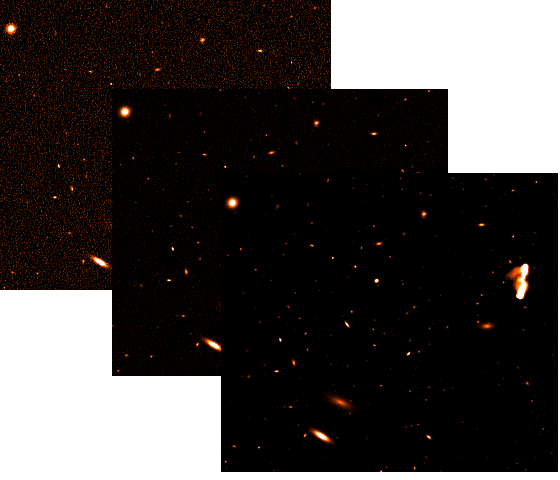SKA Science Data Challenge 1
The SKA Science Data Challenge #1 (SDC1) release consists of 9 files, with the format of FITS images. Each file is a simulated SKA continuum image in total intensity of the same field at 3 frequencies (560 MHz, representative of SKA Mid Band 1, 1.4 GHz, representative of SKA Mid Band 2 and 9.2 GHz, representative of SKA Mid Band 5) and 3 telescope integrations (8, 100, 1000 h as representative of a single, medium-depth and deep integration, respectively).
Ancillary data consist of primary beams and synthesized beams for each frequency. A training set is also released, which consists in truth catalogues listing the objects in the simulated 1000 h data and their properties for a 5% of the field-of-view.

The challenge set for the community is to undertake:
- source finding (RA, Dec) to locate the centroids and/or core positions,
- source property characterization (integrated flux density, possible core fraction, major and minor axis size, major axis position angle)
- source population identification (one of SFG, AGN-steep, AGN-flat)
The explanatory supplement SDC1 data description describes in details the data and the challenge.
The explanatory supplement SDC1 scoring method describes the scoring method use to evaluate each challenge submission.
SDC1 status: The Challenge is now closed. The challenge starting day was 26/11/2018 and the deadline for submitting results was 30/4/2019. The challenge results are presented in Bonaldi et al. (2021) MNRAS, arXiv:2009.13346.
Take on the challenge!
You are welcome to repeat the challenge exercise by yourself. If you want the challenge to be blind, you need to use the Data, Ancillary data and Training set only, and compare your findings with the Inputs revealed only at the end. If you wish to use our scoring pipeline, the format of the catalogues needs to be strictly as in the Format example
Have a taste of what SKA data will be!
You are welcome to use the data for your own research, and to perform analyses and tests beyond the set challenge. Please acknowledge the use of these data as “SKAO data challenges, science data challenge #1” (arXiv:1811.10454, where further references can be found) and Bonaldi et al. (2021) MNRAS, arXiv:2009.13346 for the challenge results.
SDC1 documents
- File
Data
| File description | File size | Repository link |
|---|---|---|
| 560 MHz, 8 hours | 4 GB | |
| 560 MHz, 100 hours | 4 GB | |
| 560 MHz, 1000 hours | 4 GB | |
| 1400 MHz, 8 hours | 4 GB | |
| 1400 MHz, 100 hours | 4 GB | |
| 1400 MHz, 1000 hours | 4 GB | |
| 9200 MHz, 8 hours | 4 GB | |
| 9200 MHz, 100 hours | 4 GB | |
| 9200 MHz, 1000 hours | 4 GB |
Ancillary Data
| File description | File size |
Repository link |
|---|---|---|
| 560 MHz, primary beam | 300 KB | |
| 560 MHz, synthesized beam | 4 GB | DOWNLOAD |
| 1400 MHz, primary beam | 300 KB | DOWNLOAD |
| 1400 MHz, synthesized beam | 4 GB | DOWNLOAD |
| 9200 MHz, primary beam | 300 KB | DOWNLOAD |
| 9200 MHz, synthesized beam | 4 GB | DOWNLOAD |
Training set
| File description | File size | Repository link |
|---|---|---|
| 560 MHz, training set | 54 MB | DOWNLOAD |
| 1400 MHz, training set | 14 MB | DOWNLOAD |
| 9200 MHz, training set | 340 KB | DOWNLOAD |
High S/N Training set (courtesy of the ICRAR team)
| File description | File size | Repository link |
|---|---|---|
| 560 MHz, high S/N training set | 54 MB | DOWNLOAD |
| 1400 MHz, high S/N training set | 14 MB | DOWNLOAD |
| 9200 MHz, high S/N training set | 340 KB | DOWNLOAD |
Inputs revealed
| File description | File size | Repository link |
|---|---|---|
| 560 MHz, truth catalogue | 870 MB | DOWNLOAD |
| 1400 MHz, truth catalogue | 230 MB | DOWNLOAD |
| 9200 MHz, truth catalogue | 13 MB | DOWNLOAD |
Submitted catalogues (all teams, frequencies and exposures)
| File description | File size | Repository link |
|---|---|---|
| Submitted catalogues | 380 MB | DOWNLOAD |
This research used the facilities of the Italian Center for Astronomical Archive (IA2) operated by INAF




